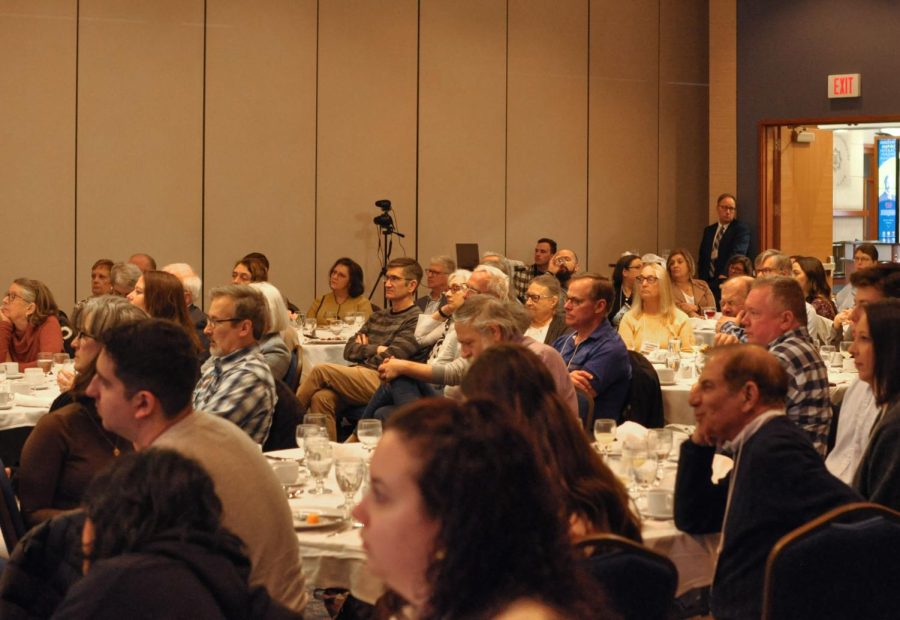Hall of Fame weekend: Alumni compare past, present state of DI
Illini Media alumni listen to Dan Balz during the brunch for the Illini Media 150 Reunion on Sunday. The reunion has allowed many alumni reminisce their time on staff with The Daily Illini.
Apr 11, 2022
Before technology, newspapers were how information was spread — everybody relied on them. Nowadays, though, there are so many mediums for communication that is causing print journalism to die, and recent resistance against news has affected media companies nationally, including The Daily Illini.
The issue is largely due to the changing trends in media consumption. Many now use social media, online news publications or TV to get their news.
This past weekend was the Illini Media Company’s Hall of Fame reunion weekend. Many past DI writers were able to reconnect with each other in the current newsroom. Together, they reflected on the old days of journalism at the University.
Melinda Miller, a writer for the DI from 1989 to 1993, said joining The Daily Illini was one of the first things she did at the University.
“I still remember coming in basically the day I got on campus and bringing my little portfolio that I wrote for the local newspaper, hoping to get a job,” Miller said. “They were like, come on in. We need anybody!”
Get The Daily Illini in your inbox!
One change the DI has undergone is its location. The newsroom used to be in Illini Hall and then First and Green, but it is now located in the University YMCA. Additionally, The DI used to publish hard copies five days a week but now only publishes once a week.
The way student reporters are viewed has changed as well. Miller said modern journalism is more “politicalized” and “adversarial” which has affected information sourcing. Now, at the University, administrators are not as open to interviews and getting information out.
“I had the vice chancellor’s home number. I could call them at night and ask them questions. They just respected the student media a lot more. I covered the administration, and I had access to all those people. It was great,” Miller said.
But the close relationships did not last, according to Miller.
“Then, when I came back later, everything was closed down. You’re kind of treated like kids now, but no, this (the DI) is a real thing,” Miller said.“What we’re doing is real. You’re informing people. It just wasn’t treated that way.”
Media has changed, which means that the way journalists get information and communicate is different too. Judith Hevrdejs-King, a DI alum who graduated in 1973, said there are new challenges for modern journalists.
“Everything has to be tweaked and adjusted for the medium,” Hevrdejs-King said. “I think that is a challenge we didn’t have to go through.”
This is the reality for journalists who had the opportunity to work in the old days of journalism and now work in its present state. Today, they must change their work to be able to fit social media outlets like Twitter and Instagram.
Monica Eng, a DI alumni who graduated in 1991, said she sees flaws in the current state of journalism.
“I mean, it’s the state of journalism,” Eng said. “Not only are they not able to pay students, but it’s hanging on by its fingernails. That’s a shame. Journalism has changed a lot.”
According to Miller, the DI also used to be an active place for businesses to advertise because of its high readership.
“By the way media is today, there are so many different advertising outlets,” Miller said. “When I was a student, advertising in The DI was what all the businesses wanted to do. That’s how you reach students. I mean, people would be reading The DI in class all the time.”
Losing readers has affected them financially. The Illini Media Company used to be able to pay its writers, which enticed more reporters to join.
“I paid all my rent through DI money,” Eng said. “I only wrote a couple of articles a week, but it paid so well. I could get those big checks.”
Undoubtedly, The DI has changed their formula too. Writing and promoting are necessary to reach everybody in these new normals, and student reporters are constantly working on reaching all audiences. For those reasons, The DI’s mission has stayed the same. It is still a place for budding writers to get their first professional experience.
“I think what it shows is that we have to adapt and adopt new models,” Eng said. “Especially if we want kids coming out of here to be employable. It doesn’t help them to be living in a fantasy world.”






